|
 Dermocybe vinicolor Dermocybe vinicolor
SynonymsCortinarius vinicolor
BiostatusPresent in region - Indigenous. Endemic
Images (click to enlarge)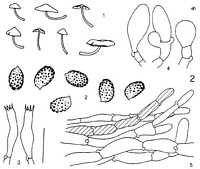
Caption: Dermocybe vinicolor: 1. carpophores. – 2. spores. - 3. basidia. - 4. cheilocystidia. - 5. pileipellis. | 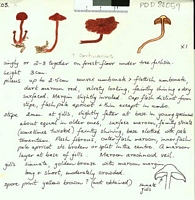
Caption: Watercolour
Owner: G.M. Taylor | 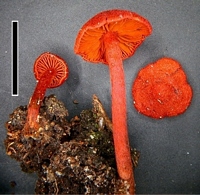
Caption: scale=1cm. Colours too orange.
Owner: J.A. Cooper | 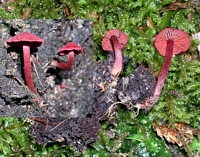
Owner: J.A. Cooper | 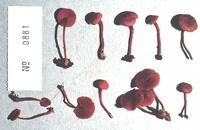
Caption: ZT0881
Owner: E. Horak: © Creative Commons Attribution-Noncommercial 3.0 New Zealand | 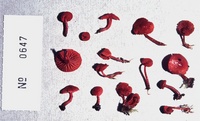
Caption: ZT0647 , Holotype
Owner: E. Horak: © Creative Commons Attribution-Noncommercial 3.0 New Zealand |
Article: Horak, E. (1988) [1987]. New species of Dermocybe (Agaricales) from New Zealand. Sydowia 40: 81-112.
Description: Pileus -25 mm, hemispherical, convex or campanulate becoming umbonate-expanded; brilliant cinnabar red, blood red or wine red; strongly fibrillose to velutinous or minutely squamulose; dry, non-striate margin, veil remnants none. - Lamellae 8-12, -3, adnate to emarginate, ventricose, -3 mm wide; concolorous with pileus later turning rust brown, edges concolorous, fimbriate to serrulate from cheilocystidia. - Stipe -30 x 1(-1.5) mm, cylindrical, occasionally swollen at base, slender, single or cespitose; concolorous with pileus, base often covered with orange-ochre fibrils from universal veil (but without distinct cortina); dry, fibrillose, hollow, basal tomentum often well developed. - Context cinnabar red. - Odour and taste not distinctive. - Chemical reactions on pileus: KOH, HCl - negative.
Spore print rust brown. - Spores 5-7 x 3.5-4 µm ovoid, verrucose, especially at apical end, warts sometimes embedded in perispore, rust brown. - Basidia 18-30 x 5-8 µm, 4-spored, cylindrical but also uniform. - Cheilocystidia composed of cellchains with clavate to broadly ovoid terminal cells (15-55 x -22 µm), membranes thin-walled, with brown to red-brown plasmatic pigment. - Pileipellis a cutis or trichoderm composed of cylindrical hyphae (5-18 µm diam.), terminal cells cylindrical, membranes not gelatinized, with brilliant red plasmatic pigment (rarely also encrusting) which readily dissolves in KOH. - Clamp connections present.
Habitat: On soil (occasionally also on rotten wood) in Nothofagus-forests. - New Zealand.
Notes: D. vinicolor is recognized by the brilliant cinnabar red of its rather small carpophores and the coarsely verrucose, subglobose spores. In New Zealand Nothofagus-forests basidiomes of this taxon often occur in large numbers both among litter on soil and on rotten wood of southern beeches.
The pigment pattern observed in D. vinicolor is dominated by high concentrations of emodin-emodinglucoside (both compounds being absent in the related D. purpurata) and dermocybinglucoside (KELLER & al., 1988).
|